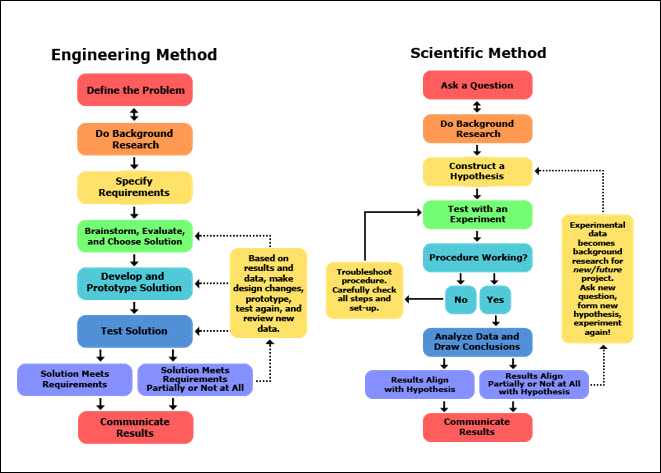THE ENGINEERING DESIGN CYCLE
Unit Overview
The objective of this
unit is to acquaint you with the engineering design cycle and how it is used in
problem solving.
Introduction
Imagine this: you
encounter a problem. You think you may have a few ideas for a possible
solution, but it will require some building. Should you use the scientific
method to help you solve the problem? How do you tell?
By this point you are
familiar with the scientific method, but have you heard of the engineering
design cycle? There are similarities and differences between the two. The
engineering design cycle is a series of steps that is followed by engineers in
order to find solutions to problems. Most often the solution leads to building
or designing something to help with the problem.
While the scientific
method can also be used to identify and solve problems, these two
problem-solving methods are used in different circumstances. If you have a
problem that leads to observations and conducting experiments, you need to
follow the scientific method. If you have a problem that leads to designing,
building, and testing a device, you should follow the engineering design cycle.
So if you think back to the problem you’ve encountered, in which the solution
requires you to build something, you should use the engineering design cycle.
Steps of the Engineering Design Cycle
The engineering design
cycle, also called the engineering design process, is a series of steps taken
to design, build, and test a device in order to solve a problem. But how,
exactly, are the steps different from those in the scientific method? Take a
look at the diagrams below to compare the engineering design process with the
scientific method.

This helpful table from www.sciencebuddies.org lists the steps of each for straightforward
comparison:
|
The Scientific Method |
The Engineering Design Process |
|
State your question |
Define the problem |
|
Do background
research |
Do background
research |
|
Formulate your
hypothesis, identify variables |
Specify requirements |
|
Design experiment,
establish procedure |
Create alternative
solutions, choose the best one and develop it |
|
Test your hypothesis
by doing an experiment |
Build a prototype |
|
Analyze your results
and draw conclusions |
Test and redesign as
necessary |
|
Communicate results |
Communicate results |
It is important to note
that the steps may have different names in different resources, or you may see
various charts or diagrams that have minute differences when you compare them.
The overall process of the design cycle is what is important, not the exact
wording of the steps involved. The main parts are identifying the problem,
designing/building/testing a prototype to help solve the problem, redesigning/retesting
as needed, and analyzing and communicating results.
Now, you will take a look
at a specific problem and apply the engineering design process in order to find
possible solutions. Follow along with the example in this article from Khan
Academy.
Click on the icon below.
The article mentions two
examples of innovation with football equipment: a football and gloves. When
thinking about a football, did you imagine it has undergone such lengthy
testing and design changes to develop the footballs used today? How would the
engineering design cycle be applied in this example?
Someone thinks that a
football designed differently may gain more forward yardage in passing. That
person or group of people brainstorm to come up with a plan to change something
about the design of the football. Several plans are evaluated and then a
prototype is built from the most favorable design. The prototype is tested to
see whether more forward yardage is gained from the new design and results are
communicated.
Using the Engineering Design Cycle
You will now use the
engineering design cycle to solve a problem. Download the following attachment
and complete the activity. Submit as question #4 in the assessment portion of
the unit.
 Now answer
questions 1 through 4.
Now answer
questions 1 through 4.
